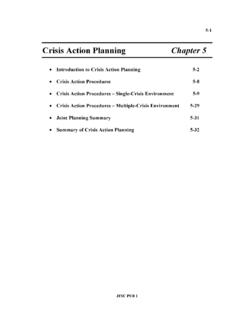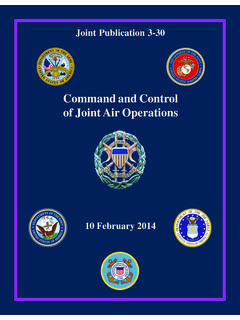Transcription of Training Gaps for the One System Remote Video …
1 ARI Research Note 2012-08 Training Gaps for the One System Remote Video Terminal: Observations from the Joint Readiness Training Center John Lipinski Martin L. Bink Army Research Institute September 2012 United States Army Research Institute for the Behavioral and Social Sciences Approved for public release, distribution is unlimited Army Research Institute for the Behavioral and Social Sciences Department of the Army Deputy Chief of Staff, G1 Authorized and approved for distribution: BARBARA A. BLACK, MICHELLE SAMS, Research Program Manager Director Training and Leader Development Division Technical Review by Clinton R. Irvin, Army Research Institute NOTICES DISTRIBUTION: This Research Note has been cleared for release to the Defense Technical Information Center (DTIC) to comply with regulatory requirements.
2 It has been given no primary distribution other than to DTIC and will be available only through DTIC or the National Technical Information Service (NTIS). FINAL DISPOSITION: Destroy this Research Note when it is no longer needed. Do not return it to the Army Research Institute for the Behavioral and Social Sciences. NOTE: The findings in this Research Note are not to be construed as an official Department of the Army position, unless so designated by other authorized documents. i REPORT DOCUMENTATION PAGE 1. REPORT DATE (dd-mm-yy) September 2012 2. REPORT TYPE Final 3. DATES COVERED (from.. to) February 2011 - August 2011 4. TITLE AND SUBTITLE Training Gaps for the One System Remote Video Terminal: Observations from the Joint Readiness Training Center 5a. CONTRACT OR GRANT NUMBER 5b. PROGRAM ELEMENT NUMBER 622785 6. AUTHOR(S) John J. Lipinski ( Army Research Institute) Martin L. Bink ( Army Research Institute) 5c. PROJECT NUMBER A790 5d. TASK NUMBER 310 5e.
3 WORK UNIT NUMBER 7. PERFORMING ORGANIZATION NAME(S) AND ADDRESS(ES) U. S. Army Research Institute for the Behavioral & Social Sciences 6000 6TH Street (Bldg. 1464 / Mail Stop 5610) Fort Belvoir, VA 22060-5610 8. PERFORMING ORGANIZATION REPORT NUMBER Research Note 2012 - 08 9. SPONSORING/MONITORING AGENCY NAME(S) AND ADDRESS(ES) U. S. Army Research Institute for the Behavioral & Social Sciences 6000 6TH Street (Bldg. 1464 / Mail Stop 5610) Fort Belvoir, VA 22060-5610 10. MONITOR ACRONYM ARI 11. MONITOR REPORT NUMBER Research Note 2012 - 08 12. DISTRIBUTION/AVAILABILITY STATEMENT Distribution Statement A: Approved for public release; distribution is unlimited. 13. SUPPLEMENTARY NOTES Subject Matter POC: John J. Lipinski 14. ABSTRACT (Maximum 200 words): The One System Remote Video Terminal (OSRVT) is a combined System (including antennas, receiver, modem, and ruggedized personal computer) that receives and displays Video and downlink data from a variety of unmanned and manned aircraft systems.
4 The System is typically deployed either in a tactical operations center (TOC) or on a vehicle ( , Stryker) and operated by NCOs or junior officers. This information provides observers with critical near real-time battlefield information. Recently, however, informal observations by both Training personnel and Soldiers suggest that while some OSRVT operators are capable of successfully using the System to support unit operations, others struggle to incorporate its capabilities. To address this issue, the present research documents current OSRVT use at the Joint Readiness Training Center and identifies the Training gaps impeding its effective integration into tactical operations. The present results identify a range of issues impeding effective OSRVT utilization including a mismatch between those receiving formal Training and those ultimately responsible for System operation, an absence of command emphasis on System integration, and the failure of leadership to clearly specify how OSRVT information should be utilized.
5 Specific recommendations on improving the contribution of OSRVT information to mission planning and execution are also provided. 15. SUBJECT TERMS Unmanned Aircraft Systems, Training , Information Processing SECURITY CLASSIFICATION OF 19. LIMITATION OF 20. NUMBER 21. RESPONSIBLE 16. Report Unclassified 17. ABSTRACT Unclassified 18. THIS PAGE Unclassified ABSTRACT Unlimited OF PAGES 32 Dorothy Young 703-545-2378 ii ARI Research Note 2012-08 Training Gaps for the One System Remote Video Terminal: Observations from the Joint Readiness Training Center John J. Lipinski Martin L. Bink Army Research Institute Fort Benning Research Unit Scott E. Graham, Chief Army Research Institute for the Behavioral and Social Sciences 6000 6th Street, Bldg. 1464 Fort Belvoir, VA 22060 September 2012 Army Project Number Personnel, Performance 622785A790 and Training Technology iii Approved for public release; distribution is unlimited.
6 ACKNOWLEDGMENT The authors would like to express their gratitude to the Soldiers at JRTC who freely shared their time and knowledge. Their expertise and experience were critical to the success of this project. We also wish to thank Troy Clements, Glen DeBello, and Gary Lujan for their continued and critical support of this project. iv Training GAPS FOR THE ONE System Remote Video TERMINAL: OBSERVATIONS FROM THE JOINT READINESS Training CENTER EXECUTIVE SUMMARY Research Requirement: The One System Remote Video Terminal (OSRVT) is a combined System (including antennas, a receiver, a modem, and a ruggedized personal computer) that receives and displays Video and downlink data from a variety of unmanned and manned aircraft systems. This information provides observers with critical near real-time information on the battlefield. Recently, however, informal observations by both Training personnel and Soldiers suggest that while some OSRVT operators are capable of successfully using the System to support unit operations, others struggle to incorporate its capabilities.
7 To address this issue, the present research formally documents current OSRVT use at the Joint Readiness Training Center (JRTC) at Fort Polk, LA and identifies the Training gaps impeding its effective integration into tactical operations. Procedure: Observations tied to OSRVT operational use during mission-readiness exercises (MRE) were conducted at JRTC and during OSRVT Training immediately prior to the MRE ( , pre-rotational Training ). The first goal was to understand the OSRVT Training and Training context provided by the Field Service Representative (FSR) at JRTC. The second goal of these observations was to identify areas of potential Training gaps related to the operational employment of the OSRVT. This research was executed in two separate phases. The first phase (see Phase 1 Methods) was primarily exploratory and intended to identify the core OSRVT Training -utilization issues. Based on Phase 1 observations, we then developed interview protocols that allowed us to further explore these issues systematically in Phase 2 (see Phase 2 Methods).
8 Findings: The present results indentified a range of issues impeding effective OSRVT utilization including a mismatch between those receiving formal Training and those ultimately responsible for operating the System , an absence of command emphasis on System integration, and the failure of leadership to clearly specify how OSRVT information should be utilized. Specific recommendations on improving the contribution of OSRVT information to mission planning and execution are also provided. Utilization and Dissemination of Findings: The present findings suggested that undertaking any of the provided recommendations can substantially improve the contribution of the OSRVT System to mission planning and/or execution. At a broader level, they also highlight the bigger challenge of contending with new technologies and additional data in the present-day Tactical Operations Center. Whereas many technologies can in principle provide information that enhances survivability or lethality, the present results indicate that consideration of these systems in isolation and not in the context of existing force integration is problematic.
9 Effective use of information technologies such as the OSRVT depends on each System s effective integration into the Training regimen and the operational dynamics of the organization in which those technologies are placed. v Given the strong conceptual and operational links with other, newer intelligence and reconnaissance systems including Small Unmanned Aircraft Systems ( , Raven, Puma) and small unmanned ground vehicles (SUGVs), consideration of the Training and utilization issues identified here can promote more effective, efficient operational integration of these and future systems across a range of mission planning and execution contexts. vi Training GAPS FOR THE ONE System Remote Video TERMINAL: OBSERVATIONS FROM THE JOINT READINESS Training CENTER CONTENTS Page BACKGROUND ..1 METHOD ..1 Phase 1 Materials and Procedures ..2 Phase 2 Materials and Procedures ..2 RESULTS AND DISCUSSION ..2 Formal Pre-rotational OSRVT Instruction ..3 OSRVT Operations and Battlestaff.
10 3 Centrality of Command Emphasis ..4 Informal Training and Prior Operational Difficulties Linked to Training ..5 Intelligence and Tactical Information Flow ..7 CONCLUSIONS AND RECOMMENDATIONS ..7 REFERENCES ..9 ACRONYMS ..10 APPENDIX A. OSRVT LEADER INTERVIEW PROTOCOL .. A-1 APPENDIX B. OSRVT OPERATOR INTERVIEW APPENDIX C. GENERAL UNIT DATA COLLECTION SHEET ..C-1 vii viii 1 Training GAPS FOR THE ONE System Remote Video TERMINAL: OBSERVATIONS FROM THE JOINT READINESS Training CENTER Background The One System Remote Video Terminal (OSRVT) is a combined System (including antennas, a receiver, a modem, and a ruggedized personal computer) that receives and displays Video and downlink data from a variety of unmanned and manned aircraft systems. The System is typically deployed either in a tactical operations center (TOC) or on a vehicle ( , Stryker) and operated by NCOs or junior officers. By accessing information available from a range of air assets, the OSRVT can provide critical near real-time data aiding the assessment of enemy locations, battle damage, enemy terrain, potential threats and potential assets.















